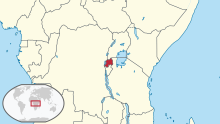
The Nymphaeales are an order of flowering plants, consisting of three families of aquatic plants, the Hydatellaceae, the Cabombaceae, and the Nymphaeaceae. It is one of the three orders of basal angiosperms, an early-diverging grade of flowering plants. At least 10 morphological characters unite the Nymphaeales. One of the traits is the absence of a vascular cambium, which is required to produce both xylem (wood) and phloem, which therefore are missing. Molecular synapomorphies are also known.

Nymphaeaceae is a family of flowering plants, commonly called water lilies. They live as rhizomatous aquatic herbs in temperate and tropical climates around the world. The family contains five genera with about 70 known species. Water lilies are rooted in soil in bodies of water, with leaves and flowers floating on or emergent from the surface. Leaves are round, with a radial notch in Nymphaea and Nuphar, but fully circular in Victoria and Euryale.
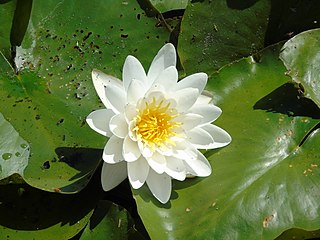
Nymphaea is a genus of hardy and tender aquatic plants in the family Nymphaeaceae. The genus has a cosmopolitan distribution. Many species are cultivated as ornamental plants, and many cultivars have been bred. Some taxa occur as introduced species where they are not native, and some are weeds. Plants of the genus are known commonly as water lilies, or waterlilies in the United Kingdom. The genus name is from the Greek νυμφαία, nymphaia and the Latin nymphaea, which mean "water lily" and were inspired by the nymphs of Greek and Latin mythology.
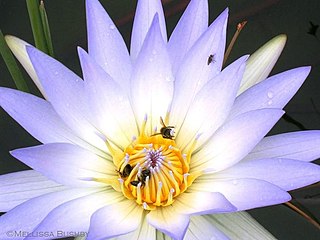
Nymphaea nouchali var. caerulea, is a water lily in the genus Nymphaea, a botanical variety of Nymphaea nouchali.

The wildlife of Rwanda comprising its flora and fauna, in prehistoric times, consisted of montane forest in one third the territory of present-day Rwanda. However, natural vegetation is now mostly restricted to the three national parks and four small forest reserves, with terraced agriculture dominating the rest of the country.

Nymphaea nouchali, often known by its synonym Nymphaea stellata, or by common names blue lotus, star lotus, red water lily, dwarf aquarium lily, blue water lily, blue star water lily or manel flower, is a water lily of genus Nymphaea. It is native to southern and eastern parts of Asia, and is the national flower of Bangladesh and Sri Lanka. In Sanskrit it is called utpala. This species is usually considered to include the blue Egyptian lotus N. nouchali var. caerulea. In the past, taxonomic confusion has occurred, with the name Nymphaea nouchali incorrectly applied to Nymphaea pubescens.

Nymphaea gigantea, commonly known as the giant waterlily or blue waterlily, is a perennial, herbaceous plant in the family Nymphaeaceae which is native to parts of northern and eastern Australia, and it has been widely cultivated elsewhere. It is an aquatic plant whose natural habitat is permanent and semi-permanent still water bodies

Barthlottia madagascariensis is the only species in the genus Barthlottia of flowering plants in the family Scrophulariaceae. The large shrub with conspicuous purple flowers is native to a very restricted area in southeast Madagascar and was described in 1996.

Nymphaea tetragona is an aquatic perennial, species of flowering plant commonly called pygmy waterlily and small white water lily, belonging to the family Nymphaeaceae.
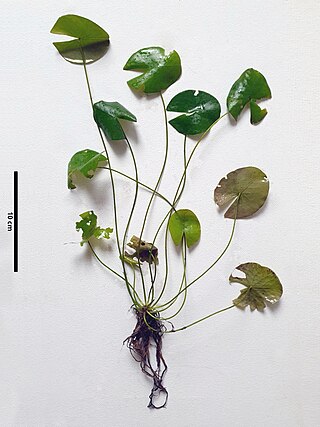
Nymphaea dimorpha is a species of waterlily endemic to Madagascar.

Nymphaea gardneriana is a species of waterlily native to Cuba and tropical South America.
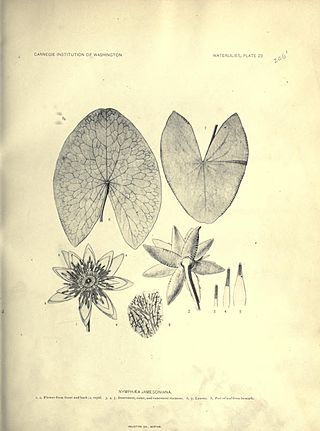
Nymphaea jamesoniana is a species of waterlily native to the USA, Mexico, and tropical South America.

Nymphaea lasiophylla is a species of waterlily native to East Brazil. It has also been introduced to the Venezuelan Antilles.

Nymphaea atrans is a species of waterlily is endemic to Queensland, Australia.
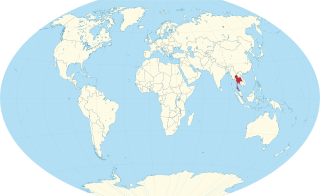
Nymphaea siamensis is a species of waterlily endemic to Thailand.
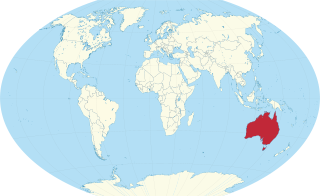
Nymphaea vaporalis is a species of waterlily endemic to Queensland, Australia.
Nymphaea pulchella is a species of waterlily native to the regions spanning from Central and Southern Mexico to Brazil, as well as from the Bahamas to the Virgin Islands, including St. Croix.

Nymphaea gracilis is a species of waterlily endemic to Mexico. It is the only species of its genus, which is endemic to Mexico.
Nymphaea guineensis is a species of waterlily native to the region spanning from tropical West Africa to Chad.

Nymphaea immutabilis is a species of waterlily native to Western Australia, the Northern Territory, and Queensland, Australia.


